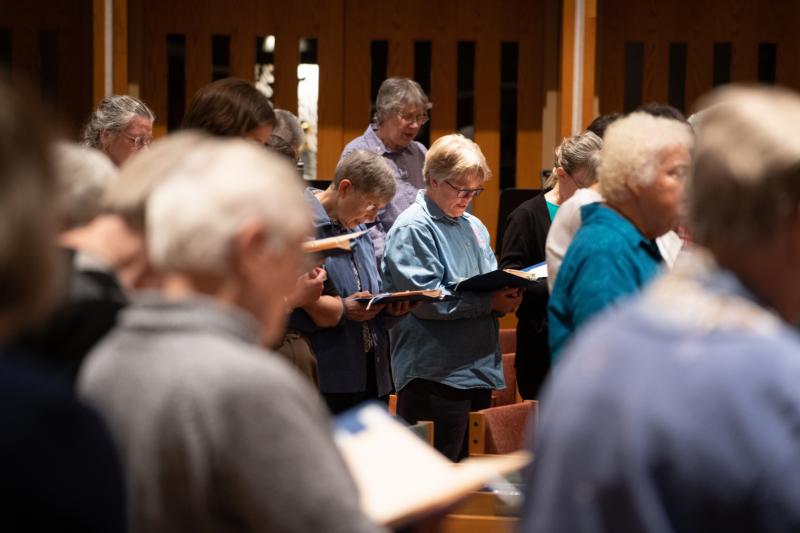
The Sisters of St. Benedict of Beech Grove, Ind., pray together Dec. 1 during their first service for Advent at the Our Lady of Grace Monastery. The sisters sang Psalms and heard a reading from the prophet Isaiah, who predicted the coming Messiah. (CNS photo/Katie Rutter)
BEECH GROVE, Ind. (CNS) — A few purple hangings and an Advent wreath were the only signs of the season in the dark chapel of the Our Lady of Grace Monastery in Beech Grove.
In the hallway just outside, the Sisters of St. Benedict quietly assembled, intentionally stopping to gather their thoughts and silently reflect.
(See a related video.)
The light appearing in darkness served as a metaphor for the 38 women religious during their Dec. 1 evening prayer as they marked the beginning of Advent, four weeks of preparation before Christmas.
Outside of the monastery walls, Christmas decorations, shopping and celebrations were in full swing. Silent, sparse and contemplative, the religious house was a stark contrast.
One expert called this liturgical season of Advent a “radical critique” of the human tendency to binge on celebration.
“We need times to contemplate and to await the coming of that which is to come, and we need time to celebrate that which is here,” said Timothy O’Malley, academic director for the Center for Liturgy at the University of Notre Dame.
[hotblock]
“In a kind of perpetual cycle of wanting to move from event to event, to have no preparation but just to celebrate and move, Advent is a radical critique,” O’Malley told Catholic News Service.
For these monastic sisters, the period of preparation began with their Dec. 1 evening prayer service. They first observed “statio,” or a short period of silent prayer and reflection before their communal service.
Then their prioress, Sister Jennifer Mechtild Horner, led the way into the dark chapel carrying a single lit candle. The sisters’ hand-bell choir and a flutist played the haunting melody of “O Come, O Come Emmanuel” as the women filed into their seats.
“For us it’s really a time of opening our heart so that we’re really ready to receive Christ when he comes at Christmas,” Sister Horner said.
“I’m waiting for Christ to come and be my light and give me a few more hints on how to live, how to live better,” added Sister Harriet Woehler.
The candlelit procession into the dark chapel, they said, symbolized Christ breaking through the darkness of the world.
Sister Horner led the sisters in a blessing before using the flame to light the first candle of their Advent wreath. The four candles serve as a visual reminder of the time passing before Christmas.
[tower]
“For me, seeing those candles lit each week, it’s a way for me to look and say, ‘Oh, where am I right now?'” said Sister Marie Therese Racine, the director of liturgy at the monastery.
One candle of the Advent wreath, the candle that will be lit on the third week, is pink to symbolize joy. The remaining three candles are purple. This color, prevalent in the seasons of Advent and Lent, is meant to represent penance.
“It actually was a very rich color, so it was a sign of this desire to pour out the fullness of one’s heart to God,” O’Malley told CNS.
“It was an expensive color, so it was a sign of real commitment,” he said.
During their evening prayer, the voices of the sisters echoed through the chapel as they chanted passages from the Book of Psalms. They also listened to a reading from the Book of Isaiah, a prophet who predicted the Messiah’s coming.
Readings from the biblical prophets are frequently contained in Advent liturgies, as are passages about Mary. O’Malley explained that Mary serves as the model for the “three comings” of Christ anticipated by Advent.
“There’s Christ coming at the end of time, there’s Christ coming as the baby, there’s Christ coming into the heart of each and every Christian who prepares a space for Christ to come,” O’Malley said.
For the sisters, the sparseness of their environment pointed to the need for this interior preparation.
“We walk around our monastery now, it’s still that quiet waiting time. You walked into our lobby and you saw the purple, it’s just a reminder that we’re not quite there yet and we need to be prepared so we really can enter the Christmas season fully,” Sister Horner explained.
Neither O’Malley or the sisters criticized the many Christmas-oriented activities that often take place during Advent, such as decorating, baking and Christmas card-writing. However, both suggested that the lay faithful integrate the spirit of penance and prayer into their Christmas commitments.
“I know for myself, yes you have to write the Christmas cards, but it’s the spirit that you do it in,” Sister Horner said.
“For me, (I) think of people and pray (over) the cards as I’m writing them, not just get them done. Not that I don’t do that toward the end,” she added with a laugh.
“This preparation is the real thing, the main thing of Christmas,” Sister Woehler said.
“It’s not all the tinsel and the elaborate — that’s nice, but the main part is the inside, the heart. To me Advent is the heart of Christmas,” she said.
PREVIOUS: Los Angeles Archdiocese adds new names to list of accused priests
NEXT: Tennessee bishops say man’s execution would not serve justice



Share this story